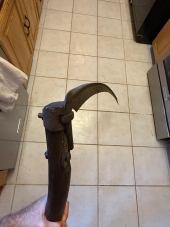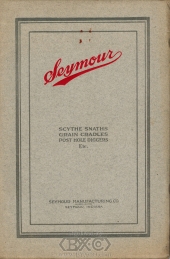

r ranson wrote:Great suggestion.
I find early morning mowing before chores or sunrise works well. But we get morning dew here.
One thing I was worried about is a spark. We have a rocky area I want to chop and drop, but it got too dry and I don't know if sparks are a possibility with a scythe. We are on the no-mower stage of summer drought because if a blade hits a rock, the grass will ignite so fast. I was hoping a scythe would have less risk.
T Blankinship wrote:
Benjamin Bouchard wrote:
Coarse scratch pattern, extra-crisp apex. Use a coarse stone to set the scratch pattern, then jump to a very fine stone. This will help eliminate any burr at the apex by cutting it off without actually erasing the "serration" of the coarse scratch pattern. Then finish with a wooden "whipping stick" to strop the blade. No polishing compound is needed -- just the bare wood. I like to make my whipping sticks from 1/2" x 2" pine or spruce, though any wood will do, and shape a grip on one end then sand the broad faces so they have a slight convex shape to them. The wood will grab any microscopic folds or unevenness in the apex at that stage and draw it straight.
This would make the blade sharper right?
Zoe Piel wrote:It's been quite some time since we got a good rain in my area. It's also been deadly hot, and I haven't been keeping up on mowing too well this summer. Now I go to mow with my grass blade and find I can't get much purchase on the dry grass. It's mostly green foxtail (with thick, horsey stems) and bermuda grass (with dry, crispy thatch underneath).
Any tips for dealing with dry dry dry grass?

Mozam Media wrote:Thank you for all of the information!!
How did you learn all of is this? Are there some resources you’d recommend making myself familiar with??


Kevin Olson wrote:
Benjamin Bouchard wrote:The iron snath is likely by Troyer Manufacturing. They later made aluminum snaths in the same fashion. Rather unique clamping mechanism and nib hardware on them.
I hadn't considered that it might be a "commercial" product, I'd simply assumed that it was made by a farmer or in someone's tractor shop to meet the needs of the moment with the materials at hand.
I'll have to give it a closer look.
Thank you for the additional info.


Kevin Olson wrote:Benjamin -
I'll have to give your current offering a read-through before I can offer helpful suggestions.
I bought a stone and holder from you a few years ago - well used, now, though I am still learning.
I started with a wooden American style snath and a brush blade (bought from a second hand store), then picked up an aluminum Seymour snath (for $5!) and moved the brush blade to that. Later, I acquired a decent grass blade on a rather pitiful wooden snath (but with one good nib, and good nib hardware for the other). Now, the grass blade is on the Seymour snath, though if I need to cut heavier stuff (tansy, small maple or box elder shoots, etc.) I won't hesitate to swap the brush blade back on. I also have a snath which appears to have been bent up from steel pipe (!) - crazy heavy, but had some good hardware on it, and was available at the right price. So, slowly piecing together a start for medieval grade mowing (I have a couple of sickles and reaping hooks, also).
I've also been doing some finish mowing with an old Craftsman "Ball Bearing" reel mower, but I may need to track down someone (maybe the local golf course?) who has a proper grinding setup for the reel and bed knife, since I have succeeded in back lapping (Pin High brand grit) a slight "hook" or recess into both ends of the bed knife, now, after several summers of use. Last summer I was rather unwell, and used the electric rechargeable mower - I just didn't have the stamina to do the job the old fashioned way. But, doing better, now, so am looking forward to getting "back into the swing of things", so to speak!.
Anyway, thanks for posting this resource for all of us scything tyros. My maternal grandfather could have given me some pointers I'm certain, but I never thought to ask when he was alive. Sorry I couldn't provide any helpful feedback, at the moment, but I will give this some time in the next few weeks.
Kevin